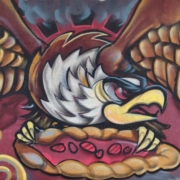5 Intention-setting Ideas to Support Powerful Emotions
When the United States was born in 1776 during the signing of the Declaration of Independence, Pluto, the planet of rebirth and transformation, was located at 27 degrees Capricorn. More recently, Pluto entered Capricorn, a sign that signifies money, dominance, power, authority and ambition in late 2008 and leaves Capricorn on January 21, 2024. Pluto reached 27 degrees Capricorn on 02/22/2022 and will do so again on July 11th and December 28th this year. As such, many astrologers consider this the U.S.’s personal Pluto return. A planetary return is when a planet revisits the same exact place in the sky, which for Pluto occurs around every 248 years!
Pluto represents destruction and construction and works to tear down things that are no longer working. Anything that is occurring during this time will be asking us to pay attention to what needs to be transformed within the US and beyond, creating upheavals in the current dynamics, such as the sexist, racism, classist, homophobic, ableism, anti-Semitism, transphobic systems put in place all those years ago. Pluto in Capricorn has removed the blinders and allowed these ugly and painful truths to be seen and felt more acutely. It has brought down people and corporations that have refused to grow and transform. It destroys what is no longer working and constructs new evolutionary ways, shifting ideology into a space of growth.
So what does this all have to do with our powerful emotions? Well, with Pluto in Capricorn, the energy is working to support the growth of the world and specifically the United States. And when there is resistance to this growth and evolution, societal upheavals are expected. And when we as humans experience such societal upheavals, powerful emotions tend to arise. And if we don’t tend to these powerful emotions, conflict may escalate not only externally but perhaps more importantly, internally.
Below are intention-setting ideas for you to consider to ride the collective and personal emotional waves as Pluto continues to push us on our journey of transformation and evolution:
- Befriend Powerful Emotions. Don’t view your emotions as the enemy as so many of us have been taught. Powerful emotions have information to share if we can simply welcome them, instead of reject them. For example, consider anger. Anger’s message is often that our needs are not being met, either because they are being ignored, invalidated, dismissed, or trampled on. Anger might be saying “I need to be seen, heard, valued, supported and/or accepted!” Perhaps think about the last time you felt anger (dare I say rage?) and get curious about what it is trying to say to you. What need or core value was not being honored in that moment? Gaining clarity around your needs, and how anger attempts to protect those needs, begins to soothe this powerful emotion as if feels heard and valued (by you!).
- Release Control!. We have also been taught that we can control our emotions. Unfortunately, this lesson has created a belief that leads many of us to disassociate, to cut off all connection between between our logical and emotional intelligence. However, under such conditions, powerful emotions tend to show up when least expected or wanted, because they will only be ignored for awhile. Perhaps think about how you might regulate or balance your emotions, not control them. For example, when we experience loss, sadness is a normal, natural human response and requires expression. If we repress it, thinking we can control it, it will shift into the space of depression.
- Accept ALL Emotions. Powerful emotions are not bad, they are human. Another step in regulating or balancing emotions is to accept all of them and honor that they are what make us human. Take guilt as an example. Most of us don’t like feeling guilt as it is uncomfortable. However, what if we accepted guilt as a guide, the primary emotion that keeps us connected to our authentic self. Perhaps consider thinking of guilt as a guide, not viewing it as a punishment making us suffer for a mistake we made. As humans, we make mistakes. That is a necessary part of learning. So, when we begin to veer too far away from our authentic self and behave in a way that elicits guilt, thank guilt for being the guard rails to our journey, instead of beating yourself up as you learn along the way.
- FACE Fear. If we don’t embrace our deepest fear, it will always be in the driver seat of our lives. This is not a conscious decision, but a reality. Embracing our deepest fear doesn’t mean we are turning the steering wheel over to it. Instead, it invites in compassion and encourages fear to loosen its grip on the wheel. To FACE your biggest fear allows space for us to engage in a dialog with it and honor how it too protects us. Consider trying the following:
- Foster an internal and external environment where awareness, understanding and choice can grow.
- Act even when experiencing fear, even in the smallest of ways, as action reduces fear and builds strength and resiliency.
- Create a current vision that comforts and sooths fear, whether in your mind to visit or perhaps a drawing or picture to look at frequently.
- Express a mantra that challenges the fear, perhaps “This fear might be real, but it is not true right now!”
- Give Shame Back. Somewhere along our journey, usually when we were very young, we internalized a message that we were bad or inadequate in some way. Shame believes it is being protective, keeping you from connecting to others in order to avoid further hurt and humiliation. In actuality, it is keeping you from accepting yourself and connecting with your authentic being. Shame needs to be given back to the person that gave it to you, is not yours to keep! Shame is like a hot potato that if we don’t give it back, we continue to pass it around to others, to try and make ourselves feel better. The shortest route to feeling better is to shine the light on shame, give it air to breath so it can die on the vine. Shame is like toxic mold. Once mold sees the light and feels the dry air, it withers and dies. Shame is probably one of the most powerful emotions keeping us small, so perhaps consider seeking the support of a trusted friend or professional counselor to support you in shining the light on the roots of any shame you are carrying under Pluto’s return, so it can be destroyed once and for all.
As always, if you try any of these intention-setting ideas for holistic health, I would love to hear about the impact they might have had for you. Please send me an email at linda@sanctuary4compassion.com to share!





